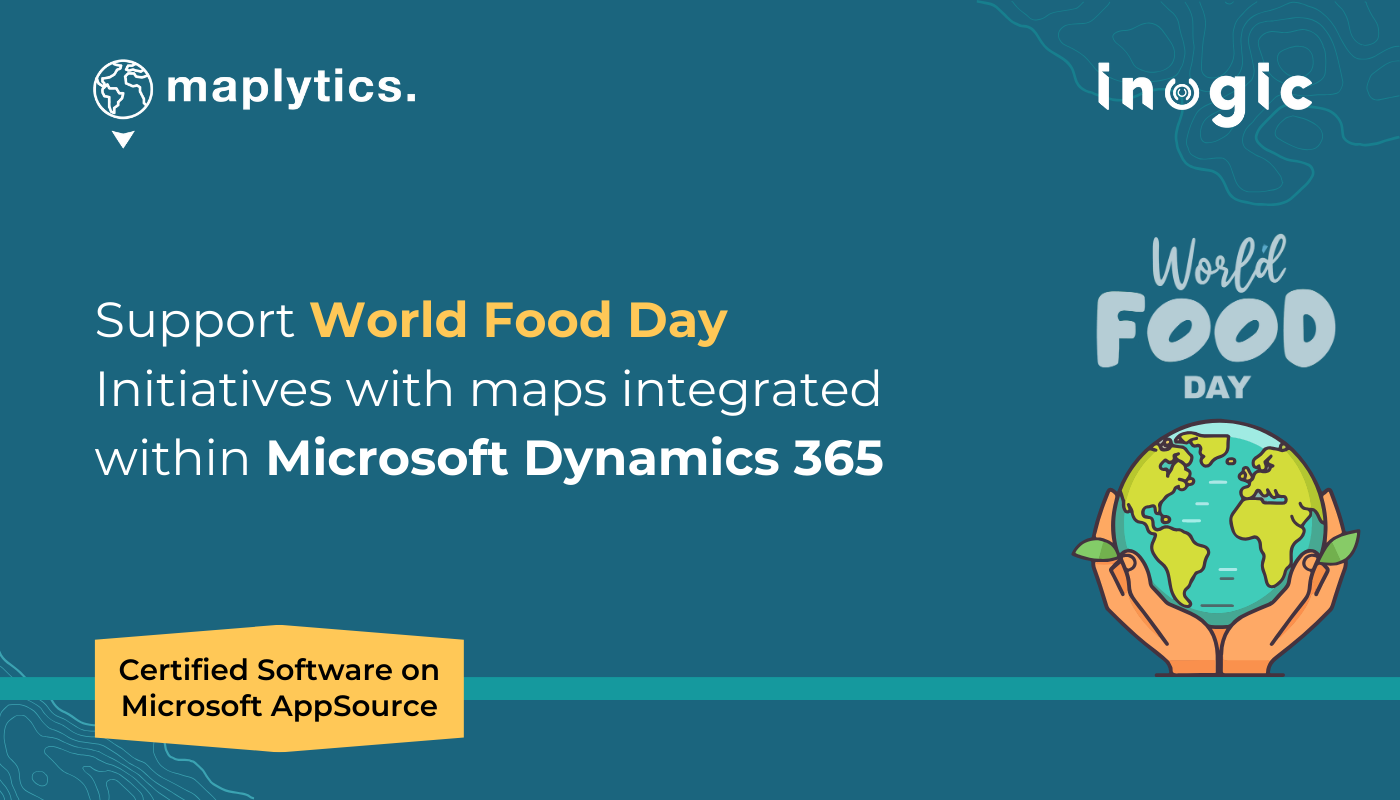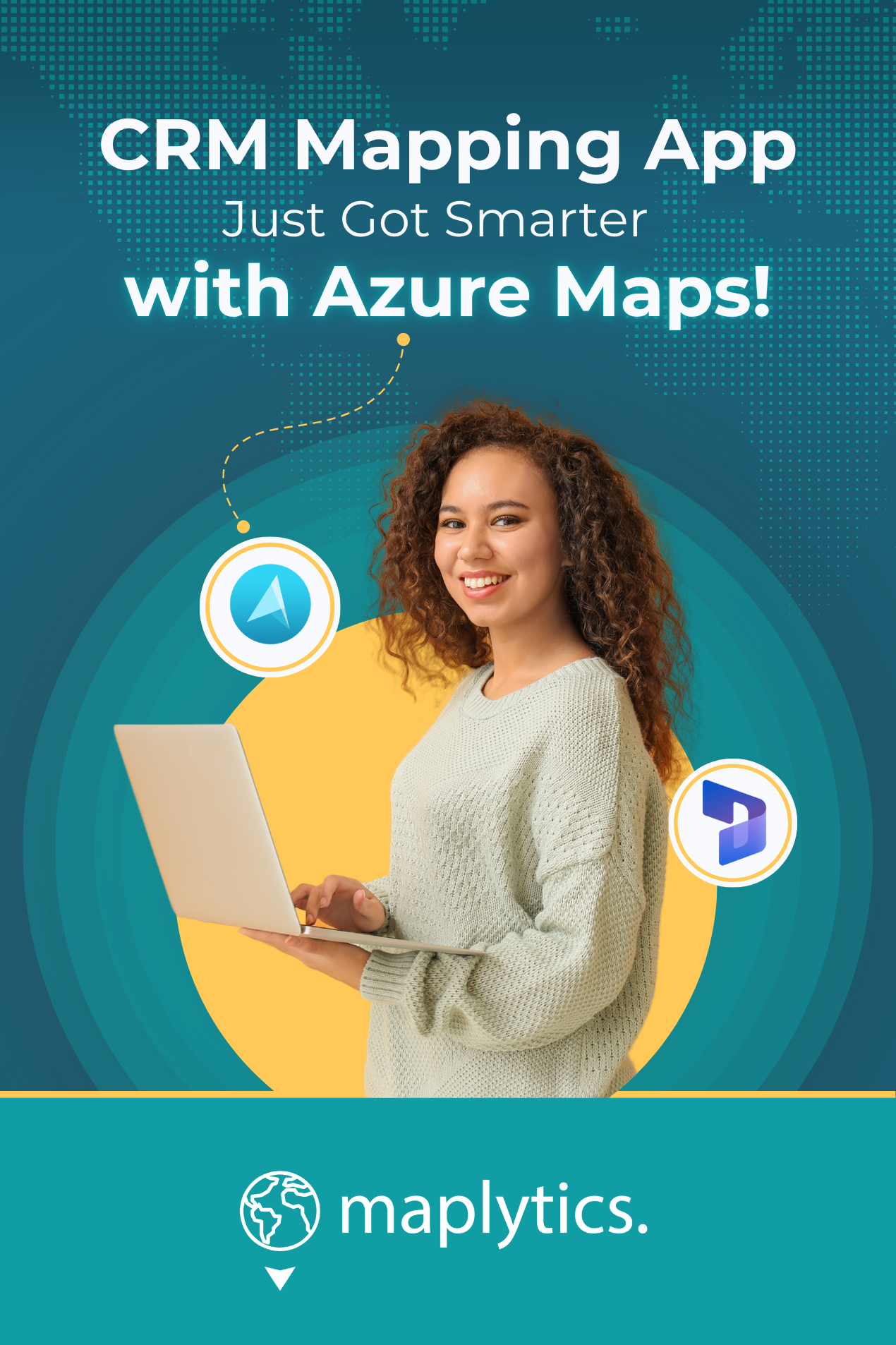World Food Day, celebrated annually on October 16th, brings together nations, organizations, and individuals to address global food security issues and fight hunger. As part of these initiatives, technology plays a crucial role in optimizing food distribution, enhancing agricultural processes, and improving the logistical aspects of food supply chains. Maplytics, a popular geospatial analytics solution integrated with Microsoft Dynamics 365 CRM can also contribute to this technological revolution. By utilizing locational intelligence and geo-mapping, Maplytics can significantly contribute to the cause of addressing global hunger, food waste, and efficient resource distribution.
This blog will explore how Maplytics can assist various organizations, NGOs, and governments to work toward achieving the objectives of World Food Day by providing actionable insights, optimizing food distribution, and empowering decision-making.
-
Optimizing Food Distribution Networks
One of the biggest challenges in tackling hunger is ensuring that food reaches the people most in need. In many parts of the world, food scarcity is not due to a lack of supply but because of inefficiencies in or a complete absence of a distribution network. Here’s how Maplytics can make a difference:
- Mapping Vulnerable Regions: Using Maplytics’ Heat Map and Census Data Analysis, organizations can map out regions most affected by hunger and food insecurity. The software allows users to visualize CRM datasets, including poverty rates, population density, and agricultural production levels. This helps in identifying food-insecure regions and allows for targeted aid distribution.
- Route Optimization: For NGOs and food distribution organizations, reducing operational costs while delivering food efficiently is crucial. Maplytics offers a route optimization feature that can help reduce fuel costs, time, and resources by calculating the most efficient delivery routes for food trucks and aid shipments. This can maximize the number of people reached with available resources, a vital factor in emergencies such as droughts, natural disasters, or conflict zones.
- Real-Time Monitoring: When distributing perishable food items, real-time monitoring for adjustments is crucial. Maplytics enables users to make real-time adjustments to food delivery routes by accounting for factors like traffic, road conditions, and emergency detours. This ensures that food reaches its destination as quickly as possible, reducing spoilage and waste.
-
Supporting Urban Agriculture and Food Banks
Urban agriculture and community food banks have become key solutions in fighting hunger locally, especially in underdeveloped and densely populated regions. Maplytics can help in managing these initiatives by providing:
- Territory Management for Food Banks: Food banks can utilize Territory Management to define service areas based on population needs. By using demographic and economic stats, food banks can create balanced territories for volunteers and donors to ensure that resources are distributed efficiently across various communities.
- Locating New Food Banks: Maplytics can help organizations identify ideal locations for new food banks based on factors like proximity to needy populations, transportation facilities, and areas with high rates of food insecurity. It ensures that the food facilities are strategically placed to reach the maximum number of beneficiaries.
- Visualizing Agricultural Efforts: Urban farming and local food production efforts can benefit from the visualization feature in Maplytics. Farmers and community leaders can use the platform to map urban farm locations, analyze soil quality in various areas, and track agricultural productivity, ensuring that food grown in urban settings is effectively allocated to nearby communities.
-
Reducing Food Waste through Smart Logistics
One-third of all food produced globally is wasted, which could otherwise feed billions of people. Tackling food waste requires streamlining supply chains and improving logistical operations to ensure food doesn’t spoil or go unused. Maplytics can play a significant role here:
- Tracking Perishable Goods: Maplytics enables organizations to track the movement of perishable goods through every stage of the supply chain. By visualizing real-time locations of food shipments, stakeholders can monitor transportation times and take proactive steps to avoid delays that might lead to spoilage.
- Visualizing Surplus Food Sources: Many restaurants, supermarkets, and farms regularly dispose of surplus food that could be repurposed for donation. Maplytics can help by providing visibility into where surplus food is frequently located and facilitating partnerships with food rescue organizations to collect and redistribute this food to those in need.
- Collaboration with Local Partners: By using Maplytics, businesses can easily find nearby donors, and partners to donate excess food. For example, grocery store chains or food manufacturing organizations can use POI Location to identify local shelters, food banks, and non-profits that can accept their surplus. This reduces food waste and ensures that the excess food is put to good use.
-
Empowering Decision-Making through Data Visualization
One of the core strengths of Maplytics is its ability to provide clear and insightful visualizations of data. For organizations tackling hunger on a global or local scale, data-driven decision-making is essential. With Maplytics, NGOs and governments can:
- Identify Food Supply and Demand Trends: By visualizing food supply chains and overlaying demand data, Maplytics users can gain insights into food production trends, shortages, and surpluses. This helps organizations forecast where additional resources will be needed and adjust their food distribution plans accordingly.
- Custom Dashboards: Maplytics offers features to create custom dashboards that track the performance of food distribution initiatives. Whether it’s monitoring the effectiveness of a food bank’s service or evaluating the impact of government food aid programs, organizations can quickly gather the insights they need to improve operations.
- Advanced Analytics for Crisis Response: In the event of a food crisis due to natural disasters, pandemics, or conflicts, Maplytics can help with quick data analysis to map the affected areas and identify where urgent food relief is needed. These insights ensure that resources are allocated efficiently during emergencies.
-
Collaborating with International Agencies
Global hunger and food security challenges require collaboration between various agencies, NGOs, and governments. Maplytics provides the platform for such collaborative efforts by:
- Sharing Data Across Borders: Organizations working in different countries can collaborate by sharing geospatial data, connecting over Microsoft Teams, and ensuring that everyone involved in the food aid supply chain has access to the same information. This minimizes duplication of efforts and ensures that aid reaches the most vulnerable.
- Cross-Organization Planning: Maplytics enables collaboration between governments, NGOs, and private companies to coordinate food relief efforts. By plotting the locations of distribution centers, local partners, and beneficiaries, organizations can plan synchronized efforts and reduce inefficiencies.
As the world continues to grapple with food security challenges, leveraging cutting-edge technologies like Maplytics can make a significant difference. With its ability to optimize routes, manage territories, monitor travel in real-time, and provide clear data visualizations, Maplytics empowers organizations to better serve communities in need and ensure that food reaches the most vulnerable populations. Through smart use of geographic data, Maplytics provides hope that technology can be a powerful ally in solving one of the world’s most pressing challenges: hunger!
What’s More?
Maplytics is like water that can be molded into any role. It makes map integration within Dynamics 365 look seamless. Radius Search, Route Mapping, and more have become super easy to use. To get more acquainted and experience it first-hand, one can write to crm@inogic.com To investigate the product further, with a personalized demo within Microsoft Dynamics 365 CRM / Dataverse get in touch with the team. For applied knowledge, do visit our Website or Microsoft AppSource. One can hop on to the detailed Blogs, Client Testimonials, Success Stories, Industry Applications, and Video Library for a quick query resolution. You can check out our technical tutorial video series #KnowYourMaplytics here and for fun Tips & Tricks about Maplytics have a look at our series #ProAtMaplytics here. Technical docs for the working of Maplytics are also available for reference.
You can also leave us a review or write about your experience on AppSource or G2 Website.




